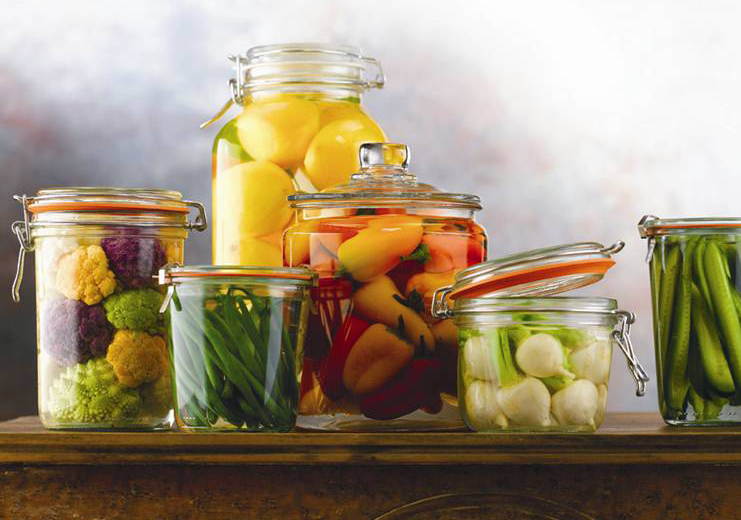Make Your Own Probiotic-Rich Fermented Foods at Home

By now, you’ve certainly heard a thing or two about the health benefits of probiotics.
Digestive microbiology has only just started to gain an understanding of our internal ecosystem, which is made up of somewhere between 500-1000 different species of bacteria.
One thing’s for sure, though: these little critters play a massively important role in the maintenance of your health. When they’re not happy, you won’t be either. Microbiome imbalance has been linked to all sorts of health problems, including immune deficiency, obesity, and diabetes.
As this field of research continues to develop, I’m sure we’ll see an increasing body of evidence demonstrating that it’s absolutely essential to take care of our gut flora.
Getting (creatively) started
While there’s lots of great probiotic products on the market, one of the most creative and affordable ways to get your beneficial bacteria fix is to make your own fermented foods at home.
It’s not nearly as hard as you may think, and the results are well worth the effort.
Besides, there’s something magical and empowering about creating your own food and health products. Our consumption-addicted society likes it when we value the convenience of shopping more highly than self-reliant freedom.
While the bounty with which the food and health product industry provides us is certainly something to be grateful for, it’s also nice to remind ourselves of this simple truth: we are fully capable of taking care of ourselves.
So in the spirit of DIY healthy eating, here’s some probiotic-rich fermented foods that you can easily make at home. Most of these foods require minimal prep-work, and then you simply wait for the beneficial bacteria work their magic.
Sauerkraut is a classic and delicious fermented food that’s incredibly simple to make—and it’s packed with beneficial bacteria that will keep your microbiome strong and healthy.
Essentially, all that you need to make it is cabbage and salt (3 pounds of cabbage and 1.5 tablespoons of salt is a good ratio), as well as a mason jar or other fitting fermentation container. This simple recipe is a great way to get started.
Pickled vegetables are another straightforward class of fermented foods. They also allow you to add lots of variety to your repertoire, because you can pickle pretty much any vegetable (I find carrots and beets particularly delicious).
Try to avoid pickling recipes that call for sugar or whey (including inflammatory and health-sapping substances seems entirely beside the point). Instead, use salt or lemon juice, like in this recipe.
Yogurt is also incredibly easy to make (don’t let the fancy packaging of store-bought packaging fool you). Basically, you just combine a bit of your favorite pre-made yogurt with the milk type of your choice. Learn more by reading this recipe.
Remember that milk carries an assortment of potential health issues with it. Try making yogurt with coconut or almond milk instead, or at the very least, make sure that your cow’s milk is organic (and preferably raw).
Kombucha preparation is a great hobby to take up if it’s your probiotic medium of choice (continually buying it from the store can get very expensive).
Making kombucha is a bit more of an intensive process, but lots of people will tell you that’s it’s worth it. It’s a sort of alchemy—a relatively simple process with endless variations for you to play with. You can learn exactly what teas, fruits, spices, and flavors you prefer. It’s also pretty neat to cultivate a connection with a living “mother culture.”
Here’s a great place to get started.
Fermented juice is a healthy twist on a classic beverage. Read this fermented apple juice recipe, and apply the process to your favorite kind of juice.
Just remember that juices are processed as simple sugars by the body (which means they spike insulin and can lead to all the same nasty effects as processed sugar). Enriching them with probiotics certainly makes them more healthful, but you still shouldn’t go overboard.
Drinking vinegars are highly medicinal, and once again, very easy to make. Apple cider vinegar has long been celebrated as an immune system tonic and natural cold remedy. You’ll see from this article that there’s a huge variety of possible recipes available to you.
Drink them straight, or use them as ingredients in smoothies, juice blends, and salad dressings, so that even more of your diet becomes enriched with probiotics.
Now the real fun begins
Once you’re hooked on fermented foods, you’ll be happy to find that there’s a whole fermented foodie culture (no pun intended) awaiting your exploration.
There’s seemingly no end to the delicious and interesting recipes that the community has created. Find your favorites (or make up your own), and integrate these incredible foods into your life for vibrant health and wellness.
|
||
|
